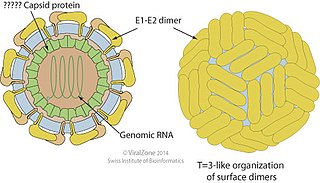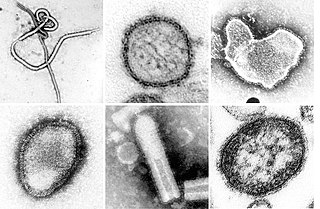
In genetics, complementary DNA (cDNA) is DNA that was reverse transcribed from an RNA. cDNA exists in both single-stranded and double-stranded forms and in both natural and engineered forms.

Metagenomics is the study of genetic material recovered directly from environmental or clinical samples by a method called sequencing. The broad field may also be referred to as environmental genomics, ecogenomics, community genomics or microbiomics.
Mady Hornig is an American psychiatrist and an associate professor of epidemiology at Columbia University's Mailman School of Public Health. A physician-scientist, her research involves clinical, epidemiological, and animal model research on autism and related neurodevelopmental conditions. She directs the clinical core of an international investigation of the role of Borna disease virus in human mental illness and participates as a key investigator for the Autism Birth Cohort (ABC) project, a large prospective epidemiological study, based in Norway, that is identifying how genes and timing interact with environmental agents preceding the onset of autism spectrum diagnoses. In 2006, she was appointed as guest professor at the school of basic medical science of Beijing University in Beijing, China.
Anelloviridae is a family of viruses. They are classified as vertebrate viruses and have a non-enveloped capsid, which is round with isometric, icosahedral symmetry and has a triangulation number of 3.
In the diagnostic laboratory, virus infections can be confirmed by a myriad of methods. Diagnostic virology has changed rapidly due to the advent of molecular techniques and increased clinical sensitivity of serological assays.

Walter Ian Lipkin is the John Snow Professor of Epidemiology at the Mailman School of Public Health at Columbia University and a professor of Neurology and Pathology at the College of Physicians and Surgeons at Columbia University. He is also director of the Center for Infection and Immunity, an academic laboratory for microbe hunting in acute and chronic diseases. Lipkin is internationally recognized for his work with West Nile virus, SARS and COVID-19.

Digital transcriptome subtraction (DTS) is a bioinformatics method to detect the presence of novel pathogen transcripts through computational removal of the host sequences. DTS is the direct in silico analogue of the wet-lab approach representational difference analysis (RDA), and is made possible by unbiased high-throughput sequencing and the availability of a high-quality, annotated reference genome of the host. The method specifically examines the etiological agent of infectious diseases and is best known for discovering Merkel cell polyomavirus, the suspect causative agent in Merkel-cell carcinoma.
Biological dark matter is an informal term for unclassified or poorly understood genetic material. This genetic material may refer to genetic material produced by unclassified microorganisms. By extension, biological dark matter may also refer to the un-isolated microorganism whose existence can only be inferred from the genetic material that they produce. Some of the genetic material may not fall under the three existing domains of life: Bacteria, Archaea and Eukaryota; thus, it has been suggested that a possible fourth domain of life may yet be discovered, although other explanations are also probable. Alternatively, the genetic material may refer to non-coding DNA and non-coding RNA produced by known organisms.

Pegivirus is the approved name for a genus of single positive-stranded RNA viruses in the family Flaviviridae. The name is a derived one: "Pe" stands for "persistent" and "g" is a reference to Hepatitis G, a former name of the C species.

The human virome is the total collection of viruses in and on the human body. Viruses in the human body may infect both human cells and other microbes such as bacteria. Some viruses cause disease, while others may be asymptomatic. Certain viruses are also integrated into the human genome as proviruses or endogenous viral elements.

Viral metagenomics uses metagenomic technologies to detect viral genomic material from diverse environmental and clinical samples. Viruses are the most abundant biological entity and are extremely diverse; however, only a small fraction of viruses have been sequenced and only an even smaller fraction have been isolated and cultured. Sequencing viruses can be challenging because viruses lack a universally conserved marker gene so gene-based approaches are limited. Metagenomics can be used to study and analyze unculturable viruses and has been an important tool in understanding viral diversity and abundance and in the discovery of novel viruses. For example, metagenomics methods have been used to describe viruses associated with cancerous tumors and in terrestrial ecosystems.

MERS coronavirus EMC/2012 is a strain of coronavirus isolated from the sputum of the first person to become infected with what was later named Middle East respiratory syndrome–related coronavirus (MERS-CoV), a virus that causes Middle East respiratory syndrome (MERS).

Bourbon virus is an RNA virus in the genus Thogotovirus of the family Orthomyxoviridae, which is similar to Dhori virus and Batken virus. It was first identified in 2014 in a man from Bourbon County, Kansas, United States, who died after being bitten by ticks. The case is the eighth report of human disease associated with a thogotovirus globally, and the first in the Western hemisphere. As of May 2015, a case was discovered in Stillwater, Oklahoma, and relatively little is known about the virus. No specific treatment or vaccine is available. The virus is suspected to be transmitted by ticks or insects, and avoidance of bites is recommended to reduce risk of infection. In June 2017 a 58-year-old female Missouri State Park employee died from an infection of the Bourbon virus after it had been misdiagnosed for a significant period of time.
ViroCap is a test announced in 2015 by researchers at Washington University in St. Louis which can detect most of the infectious viruses which affect both humans and animals. It was demonstrated to be as sensitive as the various Polymerase chain reaction assays for the viruses. It will not be available for clinical use until validation studies are done, which may take years. The test examines two million sequences of genetic data from viruses. The research was published in September 2015 in the online journal Genome Research.
Tilapia tilapinevirus, or Tilapia lake virus (TiLV), is a negative-strand RNA virus that infects both wild and aquacultured populations of tilapia. It is the only species in the monotypic genus Tilapinevirus, which in turn is the only genus in the family Amnoonviridae. Thus far it has been recorded in various regions across Asia, Africa, and South America. The virus was first discovered and identified in 2014 when the Sea of Galilee in Israel experienced a major noticeable decline in tilapia catch quantities.

Virome refers to the assemblage of viruses that is often investigated and described by metagenomic sequencing of viral nucleic acids that are found associated with a particular ecosystem, organism or holobiont. The word is frequently used to describe environmental viral shotgun metagenomes. Viruses, including bacteriophages, are found in all environments, and studies of the virome have provided insights into nutrient cycling, development of immunity, and a major source of genes through lysogenic conversion. Also, the human virome has been characterized in nine organs of 31 Finnish individuals using qPCR and NGS methodologies.
New Jersey polyomavirus is a virus of the polyomavirus family that infects human hosts. It was first identified in 2014 in a pancreatic transplant patient in New Jersey. It is the 13th and most recent human polyomavirus to be described.
HPgV-2 is the second human pegivirus discovered. It was first identified in 2005 in blood of transfusion recipients and initially named hepegivirus 1 because it shared some genetic features with both pegiviruses and hepaciviruses. HPgV-2 was later independently discovered by another group in the blood of a HCV-infected patient who had undergone multiple blood transfusions and died from sepsis of unclear etiology. It was then named human pegivirus 2. HPgV-2 is now classified in the pegivirus genus as part of Pegivirus H species.

Negative-strand RNA viruses are a group of related viruses that have negative-sense, single-stranded genomes made of ribonucleic acid (RNA). They have genomes that act as complementary strands from which messenger RNA (mRNA) is synthesized by the viral enzyme RNA-dependent RNA polymerase (RdRp). During replication of the viral genome, RdRp synthesizes a positive-sense antigenome that it uses as a template to create genomic negative-sense RNA. Negative-strand RNA viruses also share a number of other characteristics: most contain a viral envelope that surrounds the capsid, which encases the viral genome, −ssRNA virus genomes are usually linear, and it is common for their genome to be segmented.
Clinical metagenomic next-generation sequencing (mNGS) is the comprehensive analysis of microbial and host genetic material in clinical samples from patients by next-generation sequencing. It uses the techniques of metagenomics to identify and characterize the genome of bacteria, fungi, parasites, and viruses without the need for a prior knowledge of a specific pathogen directly from clinical specimens. The capacity to detect all the potential pathogens in a sample makes metagenomic next generation sequencing a potent tool in the diagnosis of infectious disease especially when other more directed assays, such as PCR, fail. Its limitations include clinical utility, laboratory validity, sense and sensitivity, cost and regulatory considerations.









